Read For Less
The Adventures of Sindbad, The Moro Affair and Great Granny Webster are the three books I would get as part of the New York Review Books Winter Sale, but lucky for all of us (but especially you) you are not me, so you very well might make other choices. You have until the end of the month, so hurry.
Terranova, "Labrador" / Black Devil Disco Club, "'H' Friend'"
Your past is your present and if you have a future it is probably that as well.
Enjoy.
Disruption Successful
“Asked if he would prefer a driver who used a GPS unit or one with a good grasp of city geography, Mr. Wissak looked at several cabs sitting idle in his lot and said, ‘Right now, I’d take them both.’”
Toile Chic
by Colette Shade
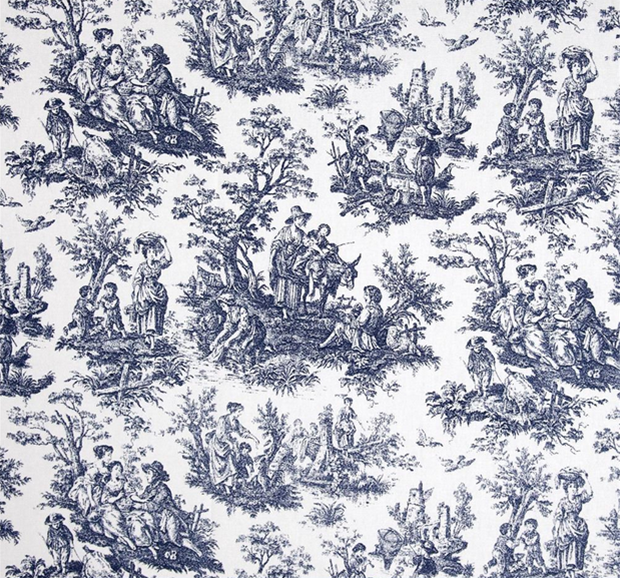
In high school, I envied a girl named Maddie because she owned a black toile handbag. If this sounds like an impossibly stodgy sartorial choice for a teenager, it’s worth pointing out that at my school, the implicit goal for many students was to dress like fifty-year-old country club members, in boat shoes and plaid sport coats and boxy Lilly Pulitzer shift dresses. It made sense: Many of them were already country club members, at L’Hirondelle or Maryland Club or BCC. They were simply getting a head start on their birthright.
Stodgy is the aesthetic that toile trades in. It’s part of the preppy interior design canon, decorating homes from Palm Beach to Bar Harbor, operating as a cipher for a certain kind of wealth. To some, toile’s monochrome peasant figures are ugly or peculiar, but no more culturally weighted an interior decorating choice than flocked wallpaper or avocado green appliances. But to those in the know, toile evokes squash games, engraved silver, lobster rolls in Nantucket, monogrammed L.L. Bean Boat and Totes coated with horsehair, and the kind of insouciance one feels when possibilities and respect are a foregone conclusion.
It’s strange but telling that affluent people continue to decorate their homes with images of happy poor people. Toile seems to hang in stately living rooms as a reminder that everything is okay, showing wealthy people how idyllic poor people’s lives can be. My parents hate toile, but have curiously never gotten around to changing the living room curtains that were there when we moved into our Baltimore home fifteen years ago. In the middle of the house, in blood red ink on ecru cotton, a clump of French peasants eats apples beneath a tree, a young boy tends to a goat, and a comely farm girl hikes up her crinoline to feed some chickens, her bosom spilling over the square neckline of her dress. When I look at those curtains, I often think of the men who come to mow and weed my parents’ yard, sweat beading on their brows in the summer humidity.
Toile’s origins are not nearly as striking as the fabric itself. The fabric’s full name, toile de Jouy (French for “cloth from Jouy”) is not a title used by textile experts, but rather a moniker embraced by decorators to denote monochrome figural prints. The style developed out of imported wood block prints from India, which became popular via trade in the seventeenth and eighteenth centuries.
But there is a man whose name has become almost synonymous with toile: Christophe-Philippe Oberkampf, whose story is equal parts Protestant work ethic and Ancien Régime materialism. Oberkampf was born to a family of Lutheran textile dyers from Württemberg. In 1759, he opened a cotton printing factory in the French town of Jouy-en-Josas, employing painter and engraver Jean-Baptiste Huet as the house designer. “His is one of the very few business that is well-documented,” Linda Eaton, the director of textiles at the Winterthur Museum in Delaware, told me. “The records from others rarely survived, or are very difficult to understand and get access too. That’s why a lot of the historical precedent is focused on Oberkampf.”
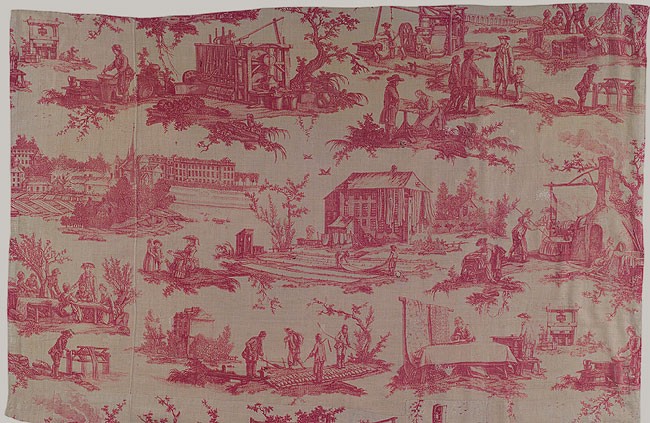
Oberkampf’s factory began production in 1760, using engraved wooden blocks to print images on cotton cloth. In 1770, Oberkampf imported a new printing technology from England and Ireland: Copper plates, which were more efficient than wood. “Printed subjects closely reflected topics in popular culture of the period,” Metropolitan Museum of Art curator Melinda Watt said. “For example, the experiments with hot air and helium balloons in the seventeen eighties prompted the design of several versions on printed cotton. Contemporary literature, opera, and theater were illustrated. There is also more than one version commemorating the death of philosopher Jean-Jacques Rousseau.” And one absurdly meta design, The Activities of the Factory, depicts the process of cloth printing at the Oberkampf Manufactory, complete with images of Huet sketching, dyers mixing pigments, and printers applying ink to the copper plates.
The fabric’s success allowed Oberkampf to become wealthy himself. Oberkampf’s newfound wealth earned him a patent of nobility from Louis XVI and the patronage of Marie Antoinette. The industrialist parlayed his toile empire into political power, becoming the first elected mayor of Jouy. By the time his factory closed in 1843, it had produced around thirty thousand unique designs.

Among the most prolific and enduring subjects was the pastoral. A typical example is Pleasures of the Farm, from the late seventeen eighties. In this pattern, much like the curtains in my parents’ living room, a pretty farm girl feeds a flock of chickens, a woman and her young boys tend to cattle, and two peasants dance beneath a tree. Such patterns were a hit with the French aristocracy and bourgeoisie, who used it to decorate rooms ensuite, the same pattern adorning bed linens, window treatments, walls, and upholstery. The soothing pastoral scenes could transform a stately bedroom into a womb of rustic sophistication.
But toile’s cheerful imagery belied France’s fomenting revolution. Most French people were subsistence farmers whose poverty was exacerbated by heavy taxes and feudal dues. In 1775, poor harvests and rising grain prices led to nationwide riots. These real life starving peasants were a stark contrast to toile’s cheerful, monochrome pastoral images. In 1788, another bread riot broke out, this one flavored by a growing dissatisfaction with the French monarchy. And in April 1789, just months before the July 14th storming of the Bastille, a riot broke out over proposed wage cuts at the Réveillon wallpaper manufactory. It is unknown whether Réveillon produced toile wallpaper. But, if you had enough money to afford toile of any kind, it could provide a comforting justification for the status quo, right there in your home.
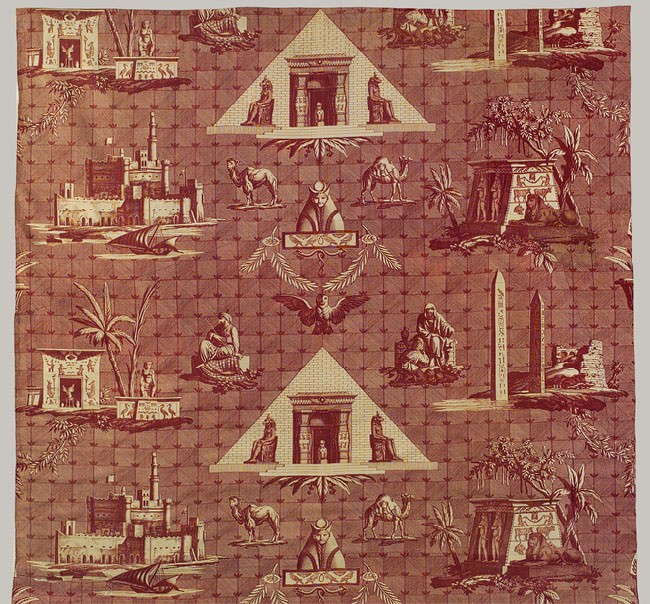
Another popular subject was France’s burgeoning colonial empire. “Exoticism in the decorative arts and interior decoration was associated with fantasies of opulence and ‘barbaric splendour,’” Sara J. Oshinsky of the Cooper-Hewitt National Design Museum wrote in her 2004 article “Exoticism in the Decorative Arts.” According to Oshinsky, Napoleon’s 1798–1799 campaign in Egypt and Syria — covered extensively in French and English language publications — had a major impact on the decorative arts. The imagery inspired by this campaign was the stuff of Edward Said’s nightmares. In 1808, the Oberkampf manufactory produced a toile pattern called The Monuments of Egypt, which features camels, pyramids, and seated, anonymous Arab men in robes and keffiyehs. And during the nineteenth and twentieth centuries, France colonized large portions of North and West Africa, the Levant, and Southeast Asia. With this growing colonial empire came fresh representations of non-Europeans as a dark, indistinguishable horde of the exotic, the decadent, the uncivilized.
Many toiles were done in a style known as chinoiserie, which filters East Asian themes through the lense of European decorative arts. A typical iteration are two unnamed Oberkampf patterns from 1770 and 1786, which both depict pagodas, bamboo, palm trees, and figures in nonspecific East Asian dress. A toile from an Alsatian factory, produced sometime between 1825 and 1830, depicts East Asian figures (again of vague origin) naively frolicking. French missionaries and merchants had been attempting to “civilize” the people of Vietnam since the mid-nineteenth century, and in 1859, France invaded Saigon, kicking off a century of brutal colonial rule in Vietnam, Cambodia, and Laos.
According to Linda Eaton, there were a few toiles that featured progressive political messages about abolishing slavery and supporting the American Revolution. But the fabric business, like any business, catered to consumer demand, so the output of such designs was limited. So how did toile find its way from France and its colonies to a living room in Baltimore? Stateside, French decorative arts have been prized since the beginning. “French influence in American decorative arts probably owes to the influx of French refugees following the French Revolution and the back uprisings in Haiti,” writes Florence M. Montgomery in her 2007 book Textiles in America: 1650–1870. Fashion magazines, according to Montgomery, also spread French fashion and decorating trends.
And in the world of fabric, everything comes back into fashion. “Nothing disappears, and nothing appears out of nowhere. Just as the individual pattern repeats incessantly over the course of a print run, its motifs are in repeat over the course of the decades,” writes Susan Meller in her 1991 book Textiles Designs: 200 Years of European and American Patterns. The same could probably be said of interior design in general. If you visit Mount Vernon — which boasts a toile-upholstered canopy bed, chairs, and curtains in one of its many bedrooms — it doesn’t look fantastically different from many contemporary homes. The fringed curtains, lyre back chairs, and rococo mirrors could all be encountered today. Like these objects, toile never really fell out of favor, and was further buoyed by several Colonial Revival periods in the nineteenth and twentieth centuries.
“The Colonial Revival movement, with its roots in a distant past, has helped successive generations of Americans ease the transition into the newness of the present and the uncertainty of the future,” architectural historian Dr. Dale Allen Gyure writes in his essay “The Colonial Revival: A Review of the Literature.” “In architecture and furniture design, the qualities of ‘refinement and dignity’ found in colonial examples, along with simplicity and proper proportions, linked colonial styles to the balance, symmetry and proportion of classical architecture. Interest in the Colonial Revival was therefore equated with timeless good taste.” Figural toiles have thus endured just like other patterns — stripes, floral toiles, ginghams. But figural toiles have a lot of visual content. Any ideologies transmitted by stripes, florals toiles or ginghams would be hard to parse. Plus, those patterns are used too broadly and possess connotations too diluted for any kind of meaningful sociological read. Toile is extremely niche-y, connoting specific places, eras, and classes. Toile, along with Chippendale furniture and Federal architecture, offer a distinctly Colonial look, in more ways than one.
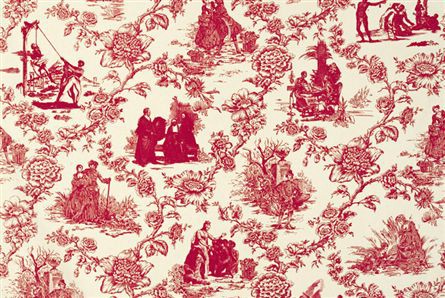
The artist Renée Green took toile’s colonial connotations literally in her 1994 work Mise-en-Scène: Commemorative Toile. In red on white, moments from France’s early colonial empire are depicted. Louis XIV signs the 1685 Code noir laws, sanctioning slavery in France’s West Indian colonies. Haitian revolutionary Jean-Jacques Dessalines hangs a French officer during the country’s fight for independence between 1791 and 1804. For exhibitions, Green decorated a room in the traditional ensuite manner, upholstering chairs, a lamp shade, and the wall. The effect is at once homey, luxurious and, when examined in detail, disconcerting.
Interior designer Sheila Bridges put another modern spin on toile with her print Harlem Toile de Jouy. “After searching for many years for the perfect toile for my own home, I decided that it quite simply didn’t exist,” Bridges writes on her website. “I created Harlem Toile de Jouy to thread my own satirical story that lampoons some of the stereotypes deeply woven into the African American experience.”
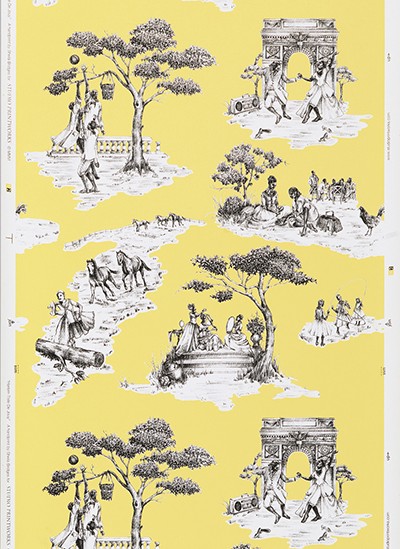
Like the original toiles, Harlem Toile has monochrome figures in eighteenth-century garb enjoying simple pleasures. But the figures are black, and the pleasures — dancing, basketball, fried chicken — carry distinctly racist overtones. Bridges takes images that most people know to be racially prejudiced and puts them in the context of something quotidian, making a point not only about the stereotypes themselves but about the insidiousness of racism, about toile, about the power of everyday objects in shaping the way people see the world. Objects — even ones that seem beautiful or benign — communicate ideologies and narratives, and sometimes those ideologies and narratives are ugly and oppressive and violent.
Toile has also inspired more lighthearted, less overtly political interpretations. Textile artist Richard Saja, who embroiders on toile fabric from decorator stores, puts blue mohawks on women, cockroaches on flowers, and clown noses on cherubs. Glasgow design firm Timorous Beasties has created dozens of toiles depicting streetscapes in New York and London, pigeons, and clouds. Former Beastie Boy Mike Diamond designed Brooklyn Toile with boutique wallpaper house Flavor Paper to decorate his Cobble Hill townhouse. The wallpaper features images of the Brooklyn Bridge, the Notorious B.I.G., and Coney Island’s Cyclone roller coaster. These appropriations aren’t so much calling into question the politics of aesthetic norms as broadening the topics they depict. But their existence demonstrates how iconic toile’s imagery has become, and perhaps why it is so appealing.
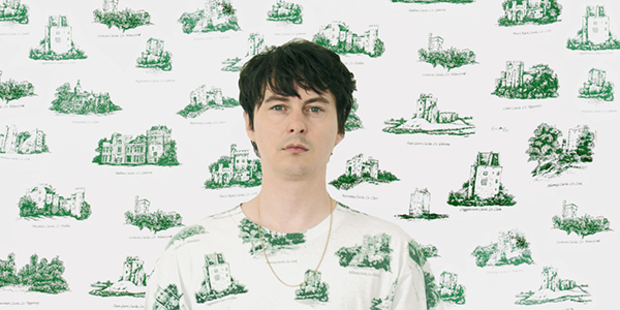
Recently, I came across a photograph of the musician Panda Bear, born Noah Lennox. He wears a green and white toile t-shirt and stands in front of a matching backdrop. Lennox grew up in Roland Park — a neighborhood not far from my parents’ house and my high school — where the houses have been in some families so long that they have covenants forbidding blacks and Jews from moving in. I couldn’t help but think that the photo shoot was a cheeky nod to his tony upbringing. After all, he named his latest single “Boys Latin,” a reference to a local prep school with a star lacrosse team and twenty-five-thousand-dollar-a-year tuition. Lennox is a soft-spoken experimental musician with an ear for the psychedelic, not a lax-playing elitist. He’s not decorating with toile to prop up his belief in the status quo. But it’s likely he grew up with the fabric, its imagery woven into his subconscious. I wonder if it makes him think of gardeners, hunched over flowerbeds in the hundred degree Baltimore heat.
I Hate Myself Because I Don't Work For BuzzFeed
by The Concessionist

The Concessionist gives advice each weekend about the sordid choices of real life. Trouble? Write today.
Hi Concessionist,
I hate myself because I can’t work for BuzzFeed. I’m sure you think this is some kind of joke since Awl editors Mr. Herrman and Mr. Buchanan diss it all the time (despite founding the tech vertical there — weird) and lots of people sneer at it but it’s the truth.
BuzzFeed is the most successful media company of our time. BuzzFeed is the future of the media business. BuzzFeed is the most widely recognized media brand among young people and will inevitably eclipse the major media organizations and one day become a super-hegemonic media power the likes of which we’ve never seen. They’re past being just a website/media organization. They’re a cultural institution. BuzzFeed is so powerful they can make the president use a selfie stick. Digiday, Adweek, and every other media rag writes about BuzzFeed’s new innovations every single day. And BuzzFeed is in perpetual growth mode. They hardly ever fire anyone (save for an unlucky few) and are ALWAYS making huge hires. Seems like every time I check an awesome person’s Twitter bio it’s changed to “Staff writer at BuzzFeed” or “Editor at BuzzFeed’ or whatever. BuzzFeed is the hottest entertainment/news/advertising/whatever property on earth right now. Everyone is talking about it and everyone (even the celebrities) reads it. Even the fact that you might answer this is a testament to how popular they are. Would you answer this if I was having an existential breakdown over Mother Jones or the Washington Post? How can you feel good about yourself if you don’t work for such a massive, popular, successful company?
The worst part is that I almost did work for them! I came really close to getting an editor position there a few years ago — before they were famous and huge. They didn’t hire me though (I told them I didn’t want to write more clickbait than substance — what the fuck was I thinking?). I applied there a few more times over the last several years and never got another series of interviews. The people they hired instead are now HUGE there — a big deal in the company and on (media) Twitter too. Like just think about getting hired there in 2011/2012 and now being one of the most important people in the entire media world and getting an interview with literally whoever you want (like imagine being able to host a BuzzFeed Brews with Chris Pratt where before you couldn’t get an interview with anyone) because you’re working for the hottest brand. Think of all the sycophants and all the Twitter followers and all the swag and every other perk of working there. Think about how amazing it must be. Now compare it to the rest of the industry…
How can I ever feel good about myself or my life knowing I’ll never have any what I described? That I fucked up the biggest opportunity I’ll ever have? That I could’ve been a figure of massive importance in the media industry but instead I’m just a nobody — at least compared to any BuzzFeed editorial staffer. I feel like Eric Stoltz after getting fired and replaced by Michael J. Fox in Back to the Future. Fox became a superstar. Stotlz did Anaconda — not far off from what I’m doing in terms of abject shittiness. I work at one of the biggest websites in the world, true, but I’m still not happy because working in the NYC media is soul-draining. The only reason to read the site I work for is if you’ve read everything on BuzzFeed already and are still bored at work (like we’re literally a BuzzFeed clone despite having started years before BuzzFeed). So myself and my whole company pretty much are just people who aren’t good enough at getting traffic to work at BuzzFeed.
Part (just PART) of the reason I feel this way is because media culture is just so fucked up and horrible. It’s so status-obsessed that I literally don’t know what to do. It’s making me hate myself. If you’re not part of the main media Twitter clique (the people who get custom-made twitter avatars from @darth — that clique) then what’s the point of even being part of the media? It’s just so hard to shake the desire to be these people (both BuzzFeed people and famous Internet people). Like if you can’t be Mallory Ortberg, Lindsey Adler, Gabby Dunn, or Amber Gordon (or like dozens of other super popular people) then what’s the point in even doing this? This business (a boy’s club, still) is hard enough for a woman but it’s even harder when you’re not social and not good at networking. Yet that seems to be the only skill that matters here — that and producing as many pageviews as possible regardless of ethics or quality. I hate myself for being some second-rate content regurgitator and listicle-producer but what else can I do?
I just… I hate this — my life. I hate living where I do (where literally every other media person lives, take a guess). I hate the media’s culture. I hate the media in general. I didn’t used to but working in it for the last few years has taught me to. I mean this business is so fucked up and I don’t understand how anyone could say otherwise… unless they work at BuzzFeed where literally everything is perfect and the industry is in great shape because you get free shit, never get fired, traffic is always going up, and the money never ends. But at the same time, I majored in this (journalism) and basically became obsessed with this to the point where I don’t know how to do anything else, and I’d certainly NEVER want to work in advertising or PR where it’s probably even worse. I don’t even know what else I’m interested in though. I just know that I devoted my life to a craft I hate and to a business that’s corrupt, insane, insensitive, sexist, and demeaning (unless you work for…).
So yeah, these problems — hating the life of a media person, hating what we’re forced to do in general, and hating myself for not working for BuzzFeed — are all sort of linked together. I know I’m taking a risk by writing this to you, but I don’t think anyone who doesn’t “get” the Internet life could help. I wish I never discovered a career in media. All it got me was a some shitty, cockroach-infested apartment that’s no bigger than a fucking broom closet and an always-increasing pageview quota. Here’s some #AdviceforYoungJournalists: Run.
Thanks,
I Don’t Work at BuzzFeed
Hi, I Don’t Work….
Let’s all take two minutes and just breathe, because this letter is so intense it makes my three remaining wisdom teeth hurt. Mandatory meditation break.

Okay. We’re back.
Let’s see.
YOU’RE FUCKED AND YOU NEED TO STOP DROP AND ROLL YOURSELF BACK TO SANITY.
No but for real.
YOU ARE IN TROUBLE.
I’m saying that with love I promise but. No one should feel this way about anything basically ever. Certainly not anything that has a paycheck attached to it. Like it would be okay to feel 50% of this way about a broken engagement, MAYBE, or like, never having hugged a dolphin. But you are waking up in a Groundhog Day of spiritual self-murder over a WEBSITE. You are sitting there SMOLDERING over a bunch of dumb 26-year-olds with blog jobs, half of whom are going to get fired or quit over the next couple years.
People at BuzzFeed are going to read this letter and be genuinely horrified. Say what you will about those little list-making monsters, at least they’re somewhat empathetic as human beings.
And I do get it, mostly. The thing is, you make one wrong follow on Twitter, and suddenly you’re inside BuzzFeed’s self-congratulatory Dutch oven. It’s weird and irritating that BuzzFeed staffers tweet about themselves and each other so much! They DON’T NEED TO. Twitter sends them no real traffic in the aggregate, and so it’s just grandstanding and showboating. But people tweet about work and stuff. That’s natural. Is it mildly irritating? Sure, but big deal! (I know, when they go on one of their defensive Twitter streaks about some article that dares to criticize them, it’s totally ridiculous. Like, YOU’LL BE FINE GUYS, DON’T WORRY. And yeah, here is the one thing I’ve learned about startups in my life: Don’t spend a lot of time defending the place you work unless you’re accruing equity.)
But this isn’t too harmful. Except… when it is. Like if you’re fragile. And self-torturing. And then! All those tweets are arms emerging from the hallways to grab at your crazy hair. And you can hear them all laughing at you while you run sobbing towards your job at the, um, I’m guessing The Ruffington Most?
Your idea about “media life” or whatever is so beyond. You’ve lost all perspective. There is no such thing. Like if you see five people on Twitter who hang out together once in a while… TRUST ME, that “scene” will pass. You need to go hang out with some bond traders or cab drivers or dog walkers.
But this is not really your fault. Financial insecurity, weird social media side effects, and the complete lack of such a thing as “the second job” in web publishing conspire to RUIN MINDS. Seriously, ask yourself: where do web writers go next, hmm? How many times have you seen someone make a non-lateral job move? Maybe five times? Ask any Gawker Media returnee! Or ask anyone who’s been writing for Gawker for four+ years! Where do BuzzFeed writers go next? WHO KNOWS! We may literally never find out.
So you’re getting all this false information. You need to turn the flow off. Unfollow everyone. Start over. Call your mother if you have one. Get a houseplant. Go to a museum. You’ve been brainwashed.
BuzzFeed is just an alternate world version of the Los Angeles Times — if, instead of being purchased by the stupid Tribune company, the Times had instead itself created Paramount Pictures, and then thrived. Then it would be a robust daily tearsheet attached to a real business. BuzzFeed — as we know it in New York — is currently organized pretty much like any newspaper of the 1960s was. (Possibly also BuzzFeed is even more like the newspapers of the 1860s even!) Either way, it is surprisingly old-fashioned. My friend Mark describes it as being identical to the old Philadelphia Inquirer. But from New York, real-power BuzzFeed is nearly invisible. Future BuzzFeed is dawning over the western horizon. BuzzFeed the web publication — totally random stupid “what color is this dress” traffic be darned — barely matters.
And one thing that’s relevant about your letter is that you’re not desperate to go work with Ze Frank and company in Los Angeles. If you really want to be on the forefront of cool-kid journalism, you should be getting your asshole steamed on video with Matt Stopera.
What’s more, why don’t you feel this way about the BBC? If you love journalism and world-wide impact so much, why aren’t you killing yourself trying to work there?
I bet you sleep with your phone and as you roll over each morning your hand slides under your pillow and as your eyes barely open you’re already pulling down to refresh your Twitter. That needs to stop now. You are CONFUSED about what is going on here. A bunch of assholes tweeting the highlights of their Best Life and Funnest Night Out is not an accurate representation of what is going on inside their own shitty apartments. Their breakups, their alcohol dependencies, their whatevers, their totally human experience of suffering.
You can be jealous of Mallory Ortberg (HEY LADY) and those other people you named that I’ve never heard of all you want, and that’s totally fair, but like, she’s sweating her ass off on her work until her bountiful hair goes limp at least four nights a week. Even though she and Roxane Gay seem to be able to tweet 20,000 times a day (and squeeze in a couple Ina Garten episodes too?), they’re still super-humanly productive. That’s because they’re WORKING AT IT.
Also, don’t be too jealous. I can promise you they do not feel good every day. And the coming burnout is much worse.
AND ALSO? You’re still talking about a bunch of POOR PEOPLE. Like these aren’t people with any authority or money, in any real terms. If you’re going to be consumed with envy, at least pick someone rich who doesn’t have to work her ass off! Be mad about those people at Vanity Fair that no one ever talks about who have TWO assistants! (What do you even do with two assistants!)
And then also I hear in your letter that this winter was hard on all of us. It was depressing and long and unfortunate. I had a psychically hard time with it too! Like, what am I doing on this planet as I get older? Why can’t people see through the motives of the most ambitious hacks around me? And also right… WHY DO I CARE? You take your eyes off the road, then you’re watching everyone’s business… EXCEPT YOUR OWN.
And what the fuck was I doing while looking over at the next lane??? Yeah, I was working, sometimes pretty hard, but I wasn’t publishing anything memorable. I wasn’t making anything good. I wasn’t doing anything at work that a bunch of other people and/or cyborgs possibly couldn’t have done. I have a pile of unfinished pieces that I don’t know what to do with, and maybe should just abandon. And what good reporting have I done this winter? NONE. What have I stayed up late into the night with, sweating bullets? NOT MUCH.
I’d ask the same of you.
There’s no doubt that Ben, Shani and Doree at BuzzFeed keep a list of people they’d love to hire and also have a list of people that they’re cold on. Even if they don’t know it! That’s how human minds work. “Oh her? Hmm, what’s she done recently….” Are they not impressed with you? You must not be very impressive, because some real fucking idiots work there! And since you care about competition so much, why aren’t you competing?
If you’re reapplying and they won’t hire you, it most likely means you haven’t done anything memorable. You’re the one with the incredibly limited — if logical! — dream of working at BuzzFeed. If you can’t make something on the Internet that makes them pay attention to you, then you shouldn’t work there and you should go get a MUCH BETTER DREAM. Like go work at a cat shelter. In their eyes, you’re just another smart angsty white woman with cute hair and a good college degree. DO YOURSELF BETTER.
If this is the battle you want to win, then strap on your ice axes and get to hacking. Turn that rage and bitterness into ACTION, not self-hatred.
Or don’t. But please. Detox. Throw your phone in the fucking East River. DELETE YOUR TWITTER. At the very least unfollow everyone and rebuild. And always remember — at least you’re not writing sponsored content for a living! Because lots of young people with dreams and journalism degrees are. And even that isn’t enough to send them into the torment you’ve made for yourself. They’re happy! And you’re a hot mess. Don’t do yourself like that.
Here’s the good news. You convinced me that I should take a week off later this month and then come back refreshed and ready to be my best self (lol). So if nobody else got anything out of this, at least I did!
• In Praise of Getting Back Together with the Dude who Dumped You
• How to Make Your Girlfriend Like You (Again)
• How Do I Live Through Getting Screwed At Work?
• Help My Friend Is A Snob!
• How To Share Feelings With Other Human Beings
The Concessionist is an adult human in New York City who is somewhat worn down and willing to make a good number of sacrifices for a peaceful life. Is it decision fatigue? Or just ennui? That’s probably a question for a psychiatrist. Anything else, ask me.
New York City, March 5, 2015

★★★★★ The subconscious, taking what it had last seen and felt before bed, dreamed of a rainy letdown, a lingering thaw. Nor did the phone ring early to announce any school closing. So it was a surprise to open the blinds onto exactly what had been forecast, a grayout of seedy little flakes already reclaiming the briefly unfrozen world. It was coming down fast enough to put a clean blue tinge on even the roadways. Snow was building on the uptown faces of traffic signs and the windward edge of poles; a schoolbus roof was lumpily furred with it. Somehow the snow was blowing all the way down the subway stairs and angling onto the landing from the left and from the right, neat and symmetrical as theater curtains. It was accumulating substantially on the hoods and backpacks of the streetwear shoppers as they stood in line. A woman walked half-twisted to talk to her companion through the narrow aperture of her hood. A minivan’s passenger-side wiper, missing its blade, thrust its uselessly twisting arm out into space. The snow had packed itself into the little seams at the top of the parka’s zipper. It fell and fell, the flakes now generously large — ideal, unfaltering, the long icy winter’s finest storm. There was no getting ahead of it or out from under: It built up on railings, windowsills, the edges of dumpsters, every detail of the city made cleaner and taller and new. It did not omit the surfaces of the fliers announcing a film shoot, or the lids of the coffee cups left by the cafe’s smoking bench. The people themselves blurred, disheveled hair mixing with the ragged supplemental hairdos of a fur hat or a ruffed hood. The slush shushed or splutted frankly underfoot. Not until the blue of twilight did the flakes dwindle, a full day’s work complete.
Here's Something Else Old New Yorkers Can Complain "Used To Be Better"
“The Holiday Cocktail Lounge, which closed in 2012, will reopen Monday under the same name in the same spot on St. Marks Place. Though the management has changed, enough of the bar’s ancient innards have been retained that old regulars will recognize a familiar friend.”
Four Common Household Mysteries Explained
by Awl Sponsors
Brought to you by Piper nv.
Ever wonder why your socks disappear in the laundry, or who keeps messing with the thermostat? Take a look below at four common household mysteries, and some simple solutions that will help you stay on top of your household’s happenings.
1. Who Keeps Messing With The Thermostat?
Why is that your house will go from toasty to frigid in a matter of seconds, even when you set the thermostat before bed? Often, a thermostat’s programmer will turn your heating system off at night, which is a big problem if you live in a cold climate and your home isn’t well insulated. Double-check the settings of your thermostat and adjust the temperature and scheduling to fit your desired preferences so that you don’t have to wake up to a freezing cold home anymore.
2. What’s With This High Electricity Bill?
Was this month’s electricity bill way higher than you anticipated? Perhaps you accidentally left a patio light on for days, or an appliance was running unnecessarily. An automated lighting and appliance control can solve this problem; it’ll monitor your home’s lighting and appliances even when you’re away.
3. Who Ate Your Lunch?
You’re running late for work, so good thing you prepped your lunch to grab and go. However, as you run down the stairs and open the fridge, you notice that your sandwich is gone — again. To catch the culprit, set up a video monitoring system that allows you to watch live or recorded HD video straight from your smartphone. Now you can prove to your roommate that he or she is a sleepwalker with an appetite.
4. Why Is The TV Remote Always Missing?
No matter how hard we try, it seems impossible to remember where we last placed our TV remote. If you live with others, look no further for the answer to this mystery. Perhaps your husband is binging on late night TV and misplacing the remote on his way to the fridge for another cold one. Work with your significant other or roommates and designate a specific spot for your TV remote, such as the coffee table or TV stand. Digging through your couch cushions will be a thing of the past.
These common occurrences can be frustrating for any homeowner or resident. But here’s one simple way to deal with your household mysteries: Piper nv. Piper nv is the only security system that can be easily tailored to focus on the things that matter most to you. It offers video and sound monitoring that you can view/hear from your mobile device, motion controls sensors, an alarm, and even the ability to control your lights from wherever you are. To learn more about Piper nv’s comprehensive features, go to getpiper.com. And check out the ”Mysteries Explained” video above. Then join the conversation by using the #MysteriesExplained hashtag.
